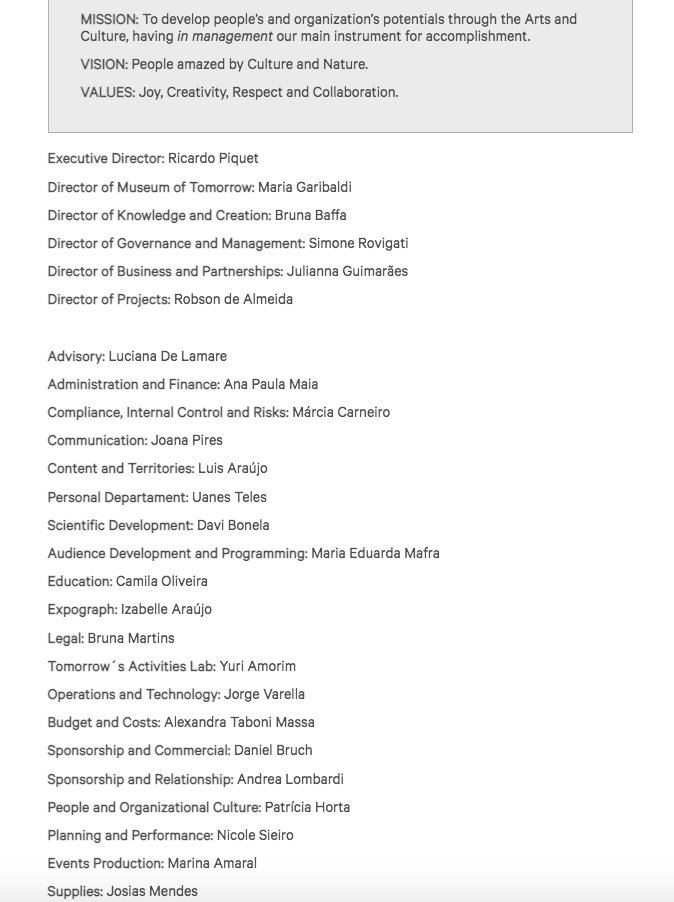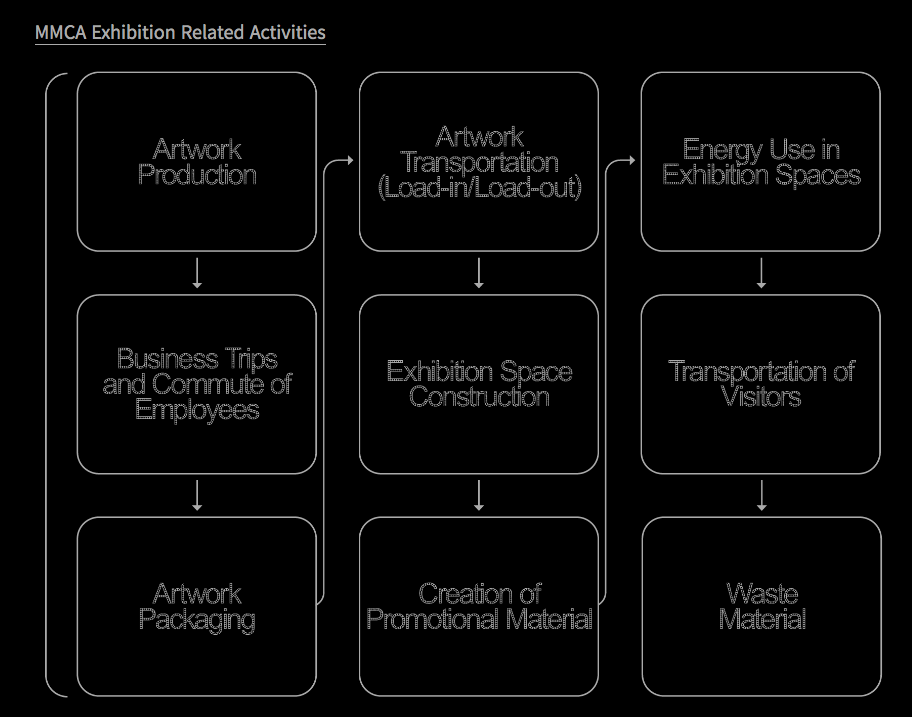Museums are thinking about the future. They think together with all scenarios and all thought patterns. Museums are thinking, looking for solutions, discussing and researching.
- Museu do Amanhã (Museum of Tomorrow):
Photograph: Museu do Amanhã (Facebook Page)
Everyone was so fascinated by the architecture and mission of the Museum of the Future (tap to read about the museum) that (rightfully) a similar situation happened before the opening of the Museu do Amanhã (Museum of Tomorrow) in 2015. At Museu do Amanhã, we first experienced the sustainable elements in the architectural design of the museum, the museum's appearance as a sustainable institution, and the elements that make the visitor think about the future. It was precisely at this point that the name of the museum was chosen as Tomorrow, not Future. The concept of the future seems distant to people, however, before the opening they said that the future is the actions we take today. This point of view is directly proportional to the museum's mission and vision, as well as the discussions and research topics it brings. Located in Rio de Janeiro, the museum draws attention for its purpose of existence as well as its interesting structure. For example, it is one of the museums that transforms the region (Praça Mauá). As museologists, we always give the Tate Modern example in these examples of urban transformation, but it would be good if we take a break from using this example. For example, we can now consider the Museum of Tomorrow as an example. While the area where the museum is located is the old port area and is a hesitant route for visits due to the high crime rates, this place suddenly takes action with the opening of the museum in the region. The transformative power of creative industries is one of the most important elements in terms of both economic and urban transformation.
We have read the definition and purpose of existence of the museum and observe that it adopts a transparent management policy while continuing to examine its official site. It is very rare for a museum to have all its stakeholders, museum professionals and names clearly seen in writing and at the same time have its mission, vision and values in full writing. This means that transparent information flow can be provided when requested. We hope that it will set an example for other museums, please some museum administrations open the Museu do Amanhã official website and examine it :) The part that got us most excited was the museum's laboratory "Activities of Tomorrow Laboratory" (LAA, by its Portuguese acronym: O Laboratório de Atividades do Amanhã). The LAA has two main focuses: the effects and results of exponential technologies and to develop these topics the space works on four fronts: education, activities, a creative residency program and exhibitions. There is nothing we are happier than when museums' laboratories and research units are active!
For further information please visit: https://museudoamanha.org.br/en - Futurium (Musée Futurium):
Photograph: Futurium (Facebook Page)
"Futurium is a house of futures." It has so many meanings, doesn't it? You can understand the scope of the museum in here. A house of futures in Berlin. One question is at the center of its lab, research center, and open discussions: it is always about the big question "How do we want to live?" The museum's Futurim Lab is an interactive and experiential space that appeals to everyone. "Experiment, test and invent – Everyone can get involved in the Futurium Lab." You can write, draw and share your ideas in the workshop environment, and you will be able to observe and reflect on some insects/as tomorrow's potential foods - luckily they will not be tasted. You can even develop your own prototypes. A wonderful experience, especially among the museum visitor types, family groups have already come to the fore in our minds! With "Your Emotional City", it is aimed to map the emotions of the city with the participation of visitors in order to make sense of the emotions and feelings of the city. While questioning the future, we cannot leave behind the place we live in and what it feels, can we? For example, will we be able to hear the feelings of cities whose green areas cannot be protected, will the museums in those regions dare to question this? We hope they do. If you would like to participate in the project as an urban researcher and join the collecting data on stress and well-being locations in Berlin, you can download the app "Urban Mind" from the App Store or Google Play: https://futurium.de/en/your-emotional-city#about-the-project
For further information please visit: https://futurium.de/en - Future Museum (Not a museum, but a collaborative project of many museums):
Because of its name, everyone thinks it is a museum. They even confuse it with other museums. It is not a museum, but a project with large stakeholders. It proceeds in two phases. The First Phase covers 2019-2021, while the Second Phase covers the period until 2023. For now...
The project was developed by Museum Booster, it might be thought of as a museum from its name, but it is a company, not a museum. A Vienna-based research and consulting firm focusing on the impact of new media technologies on arts and cultural institutions. The mission of the company is to assist museum administrators and cultural experts in selecting, evaluating and implementing new technologies, especially focusing on tools and ideas that have a positive impact on museums and can create strategic advantage. The Future Museum Project official kickoff meeting took place in Berlin in 2019. For two years, a group of 26 museums, including the Guggenheim Bilbao, the Kunsthistorisches Museum Vienna, the Munch Museet and the Swiss National Museum, as well as other stakeholders from seven countries, collaborated to identify key trends and identify current and future challenges for museums. We were particularly interested in the part that is quite interesting, especially the research questions that need to be asked: It is quite important for such long-term projects that museums can cooperate in research projects and advance on a common ground. We hope that they can maintain this continuity and we will be able to see museums in different regions to the stakeholders.
It is quite important for such long-term projects that museums can cooperate in research projects and advance on a common ground. We hope that they can maintain this continuity and we will be able to see museums in different regions to the stakeholders.
Photographs from the presentation of Future Museum. You can reach the presentation here: https://www.future-museum.com/wp-content/uploads/2022/01/2022-01-07_FM_Phase-II_Presentation_WP_MM_lowres.pdf - The Museum-Carbon-Project (The project of MMCA- The National Museum of Modern and Contemporary Art, Korea, -we mentioned that before-):
The Museum-Carbon-Project is a reflective program in the form of a series of multidisciplinary events, all of which question how we should respond to climate change in the Anthropocene. As a start, it calculates the amount of carbon emitted at every step of creating an exhibition at the MMCA. The Museum-Carbon Project is a reflective program in the form of a series of multidisciplinary activities, all of which question and discuss how we should respond to climate change in the Anthropocene. To begin with, it calculates the amount of carbon emitted at each step of creating an exhibit at the MMCA. In connection with these exhibition activities, individual projects were developed in the hope of creating an arena where people from different disciplines can come together to share their concerns and initiate a discussion. Collaborations were made with companies that focused on sustainability for the materials and details used in the exhibition and developed products with this focus. The website of the project was designed as eco-friendly guidelines. You can find our article about this project here: https://www.artandtownmagazine.com/2022/09/museums-against-climate-change-museum.html
We hope to see the laboratories and research units of the museums effective and not be limited to certain museums.







Comments
Post a Comment